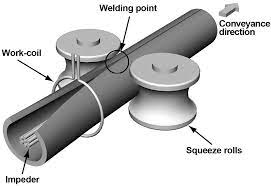
An automatic double-wire front and back arc welding process is used to weld high frequency welded pipe, which is a spiral high frequency welded pipe made of strip steel that is typically extruded at high temperatures. To create a round finishing tube with an opening gap, the strip is cold-rolled by several rolls slowly, and the amount of extruded roll thinning is adjusted to perform electric welding and welding.
The proximity effect will be diminished, the vortex heat won't be sufficient, and the welded crystals won't be able to fuse properly, leading to non-fusion or cracking, if the gap is large. The proximity effect will intensify and the welding and heating value of electric welding will be too high if the gap is small, which could cause the weld to ignite or extrude and produce pits, which would affect the weld's process performance. The extrusion roller is used after the two edges of the finishing tube have been heated to the electric welding and temperature. If the extrusion pressure of the high frequency welded pipe is too high, the molten metal material will be squeezed into the weld, which will cause a large number of internal and external vibration lines and lead to repeated weld failures. If the extrusion pressure of the high frequency welded pipe is small, the total number of crystals will be very small, and the compressive strength of the welded metal material will be reduced, resulting in Cracks.

No pollution, little noise, and no waste water or waste gas are characteristics of the production of high frequency welded pipe. Production uses circulating water cooling, which is energy-, environmentally-, and labor-efficient. For one shift, 5-8 people are sufficient. The welding speed is not slow, and the 76 unit's welding speed can range from 20 to 70 m/min. With regards to use, electric welded pipes are being used more widely and replacing seamless steel pipes in more departments and applications due to improvements in weld quality and non-destructive testing reliability. The growth rate of welded pipes is also faster than that of seamless pipes. This is the general pattern. The high-frequency welding process has many benefits and is highly adaptable to the type of tube blank material and steel tube size. High-frequency welding produces welds with minimal heat-affected zones and strong penetration in addition to speeding up the welding process. The high frequency welded pipe has good weld quality, minimal internal and external burrs, rapid welding, and low power consumption, making it suitable for widespread use and promotion. Normal production of heterosexual pipes from the high frequency welded pipe unit also results in increased production of square and rectangular pipes. Due to their large section modulus, square and rectangular pipes can withstand more bending force, which can save a lot of metal, time, and components during processing. It is widely used in many areas of industry and agriculture because of benefits like weight.